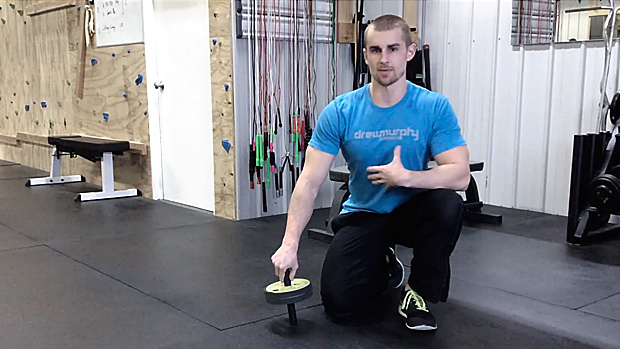Here's what you need to know...
- Max effort jumps before lifting can help you set new PRs, but the movement has to mimic the lift. A max vertical can improve a squat; a max broad jump can improve a deadlift.
- Bottom-up squats teach you how to maintain an organized and rigid position at the bottom of the squat while forcing mobility and stability changes, all leading to a bigger conventional squat.
- Although foam rolling may make you feel good, conclusive evidence shows that dynamic movement drills that increase tissue temperature are the deciding factor in increasing performance.
In the quest to build a stronger squat, lifters often get wrapped up in sets, reps, and loading schemes, but sometimes forget to focus on creating pre-set tension, stability, and an effective warm-up that doesn't waste time. With that in mind, here are three vital practices that could lead to a new PR in the squat after just a couple of weeks.
1 – PAP the Proven Way
Post-activation potentiation, or PAP, is anything done before an activity that improves the performance in that activity. Jumping or doing plyometric drills before going for a 1RM on the squat would be an example. PAP works because it improves rate of muscle contraction but, like so much in strength and fitness, the volume of PAP needed to actually improve (and not fatigue) is highly individual; each lifter has to discover his own sweet spot.
In order for max effort jumps to work, the movement has to mimic the lift. As such, a max vertical jump or jump squats could improve a squat while a maximal broad jump could improve a deadlift.
For vertical jumps, there's no need to jump up and swipe an NFL-style combine marker. All you need to do is descend into a quarter squat rapidly and jump as high as you can, raising your arms above your head and stretching out your body as long as possible. Rest a couple of seconds between each jump to make sure you jump as high as you can while trying to touch the ceiling, however high it may be. Likewise, there's no need to use a marker for the broad jump, just jump as far out as you can with each jump and rest between each attempt.
Putting It Together
- Perform a general warm-up, getting the muscles warm, and do some dynamic movement drills that include squat movements for 5-10 minutes.
- Perform your max PAP jumps with the recommended volume according to your ability level and training age. For conventional jumps, novice trainees should only perform 1-2 sets of around 5 while more advanced trainees with more than two years training may need 2-3 sets. Rest only a few seconds between each jump.
- Start your warm-up and ramp-up sets until you start hitting singles.
- Attempt your new PR, but make sure to go for that new max within five minutes of your PAP jumps. The magic should happen somewhere between the 3-5 minute range, unless you did too many ramp up sets or rested too long between them.
- Note: The more stressful the jump, the less volume you need. Stressful jumps include depth jumps that expose the body to very high forces, so one set of 5 jumps will do fine even for advanced lifters. Less stressful jumps, of which the advanced athlete would probably need 2-3 sets of 3-5 reps, include box jumps and tuck jumps (stationary jumps where the lifter jumps as high as he can, brings his knees to his chest, and then brings his legs back down before he lands.)
2 – Start From The Bottom
Coaches often give sermons about keeping tightness and maintaining posture at the top of the squat after the bar's walked out. Likewise, they emphasize a tight, rigid position before and during the descent. Despite these best efforts, many lifters who may be tight and rigid at the top still look terrible going into and coming out of the hole.
While mobility and stability drills have traditionally been used to address this problem, improving a movement requires you actually practice the movement while challenging your limits. Enter bottom-up squats. They teach how to maintain that same organized and rigid position at the bottom of the squat while forcing mobility and stability changes. If a lifter can learn to create as much tension and stability in this bottom position as he can in the top, he'll be able to lift much more weight during a conventional squat.
Setup
- Set the safety pins below parallel as your mobility and stability allows. The goal is to challenge limits, but bad practice will never yield desired results.
- Get under the bar, making sure to feel pressure on your whole foot and screwing yourself into the ground, thereby creating tension in your hips/glutes.
- Breathe into your abdomen very deeply. Exhale hard, tense the abs, and then breathe again into a tightly braced trunk before standing up in perfect position, driving with your hips.
- Take your time in the setup and be sure to exhale and inhale into that braced position before every rep.
3 – Warm-Up With Movement and Address Restrictions After the Workout
The purpose of the warm-up has been muddied and confused. If general fitness is the goal, then doing comprehensive mobility circuits and self myofascial-release techniques (foam rolling and the like) before you workout is fine. However, if the goal is to build levels of strength and muscle, then that kind of warm up is excessive and often times counterproductive.
Although foam rolling may make you feel good, conclusive evidence shows that dynamic movement drills (resembling the movement planned for that day) that increase tissue temperature are the deciding factor in increasing performance. As for the foam roller and long list of mobility drills, save them for after. The workout will reveal where you need to focus those efforts anyway.





